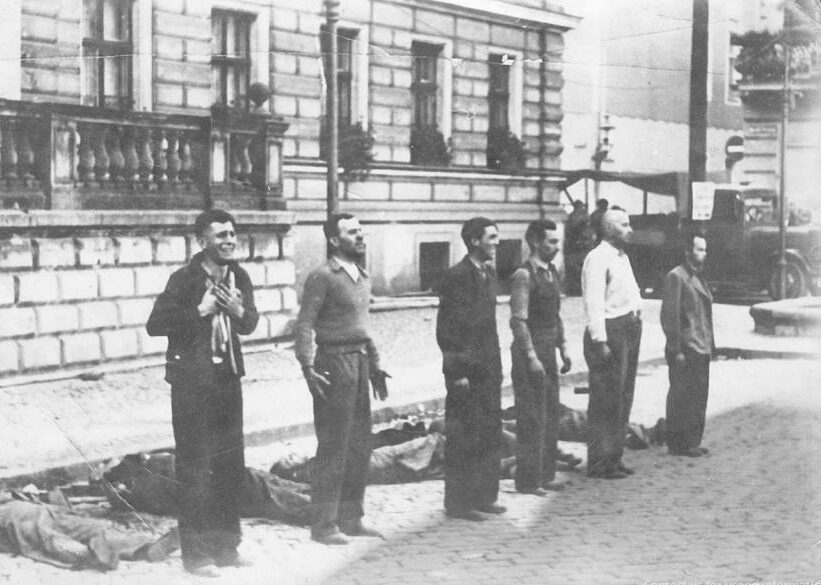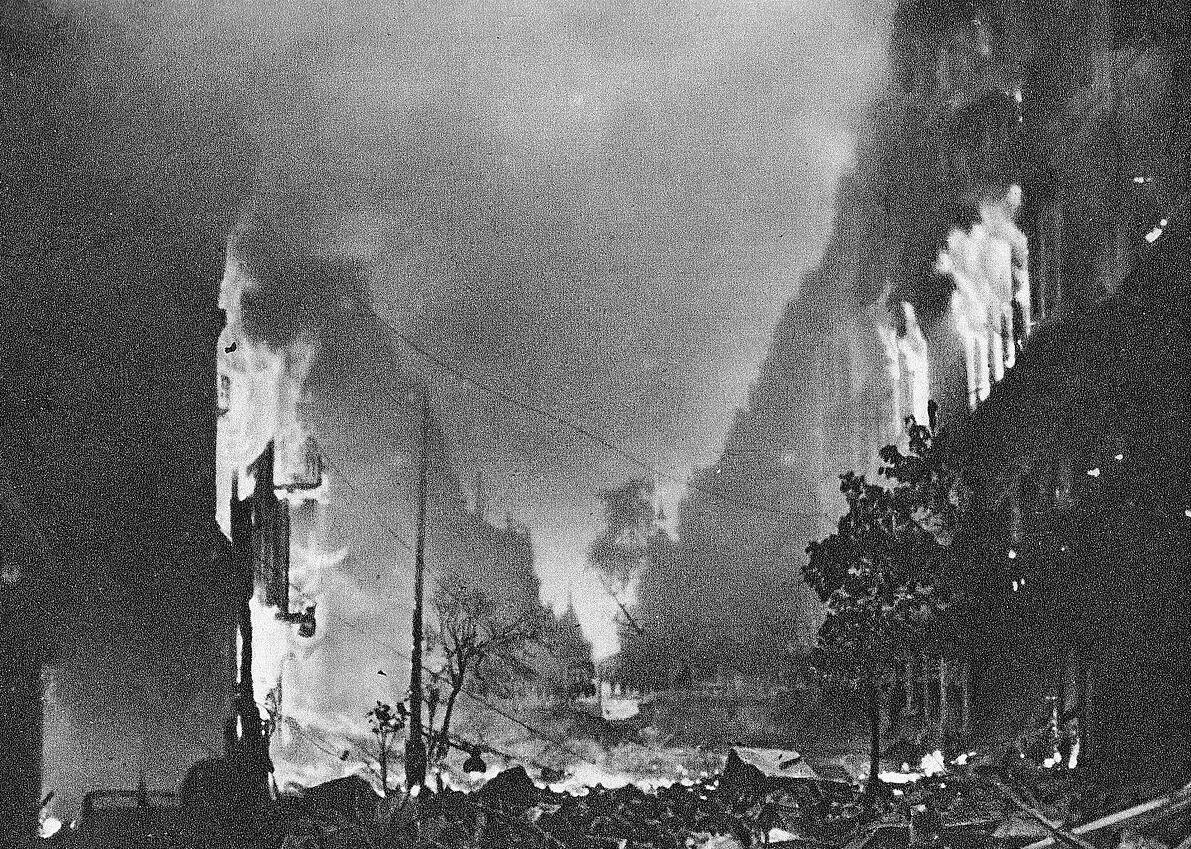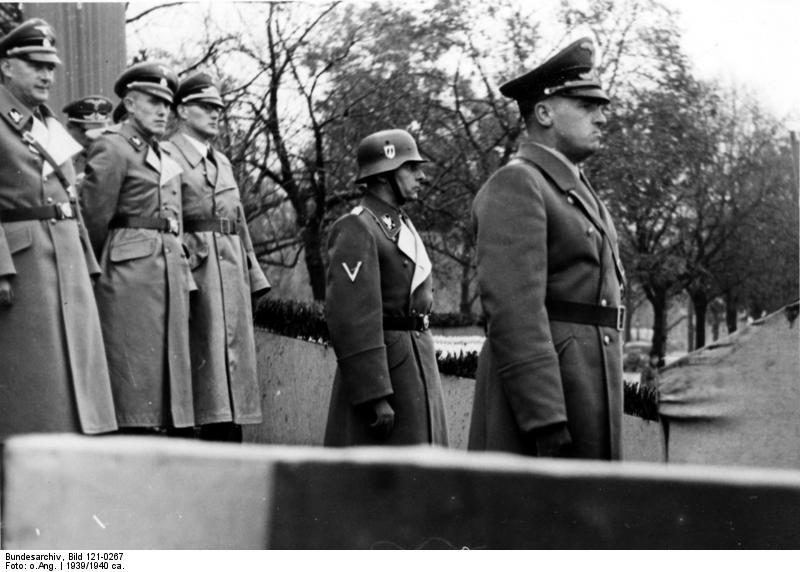A war crime on culture: How Germans robbed Poland

“43% of Poland’s historic buildings were destroyed or damaged. In Warsaw, it was as much as 92%. I think that to illustrate the scale of destruction, the example of our capital is the best. Before the war, it had a population of about 1,300,000, while in 1945, when Soviet troops entered it, there were about 200 (!) inhabitants left, the so-called Robinsons, who were hiding in the ruins. It was a city of ruins” – says prof. Konrad Wnęk, Director of the Jan Karski Institute for War Losses, historian and professor at Jagiellonian University
by Radoslaw Wojtas
The term Holocaust is known all over the world. Just as it is common knowledge around the world that Germany under the dictatorship of Adolf Hitler sought to physically eliminate the Jews. But the knowledge that during World War II, out of all European countries, it was Poland that suffered the greatest, personal and material losses in relation to total population and national assets is not so common. Before we get to the numbers, which are striking, let’s consider whether in the German plan the Polish nation was also to cease to exist? Especially in the context of Joseph Goebbels’ words uttered on the eve of World War II: “Take away a nation’s culture and it will cease to exist as a nation.”
This, naturally, was part of the plans the Germans implemented from the very beginning, from the first days of September 1939. When they occupied Polish territory, they already had a list of people who had to be arrested, placed in concentration camps. These were representatives of the Polish intelligentsia, including people of culture and science. Suffice it to mention here, for example, the most famous such action, which echoed throughout Europe, the arrest of professors of the Jagiellonian University and the Mining Academy. The liquidation of the Polish intellectual elite continued from the very beginning of the war.
And also the destruction of our cultural heritage.
In this regard, there were multiple courses of action, and these actions were perfectly planned and can be said to have been carried out with German precision. First, representatives of the cultural elite were arrested or murdered, but, as I have already mentioned, also elites of many other fields – people of science, politicians, social activists, clergy. There is such a concept as “eliticide” and Poland was a victim of eliticide. Germany’s problem with the Poles was that there were too many of us. It was not possible to murder all of us in 5-6 years, as was planned and implemented in the case of the Jews. Therefore, Polish society was treated somewhat differently from the beginning. We were deprived of our elites, our culture, our roots, so that we could later be turned into an army of farmhands, slaves who could serve the German masters. What fate would await us later? It’s not entirely clear. If the so-called Master Plan for the East, or Generalplan Ost, had been implemented, at best we would have been resettled in Siberia, and at worst, we would have met the same fate as the Jews.
Not too long ago, Poland prepared a detailed report that sought to estimate the value of our war losses. According to detailed calculations, it is more than 6 trillion zlotys. The largest percentage – more than 77 percent – constitute losses caused by the murder of 5 million 200 thousand Polish citizens. Let us add here in passing that the report speaks only of the losses inflicted by the Germans, yet death and destruction were also sown by the second occupant – the Soviet Union.
Estimates of the number of the murdered population varied. Depending on who estimated, they ranged from 4.1 million to 6 million. In preparing the report, we tried to verify everything as accurately as possible, but remember that these are still estimates that are subject to change. Let us also remember that the figure of 5 million 219 thousand given there are the losses suffered by Poland on the part of Germany, the figure on the part of the Soviets still needs to be verified. But yes, they make up the majority of the estimated losses of more than 6 trillion zlotys as a result of German actions.

The losses in the field of cultural and artistic property are also not insignificant. The Germans used four methods to destroy Polish culture: 1. looting of cultural assets 2. physical destruction 3. extermination of artists 4. liquidation of organizational bases. Let’s focus on looting for now. We lost 600 thousand objects of Poland’s cultural heritage. Is this also an estimate?
These 600 thousand are only those objects that we know about officially, but this is only a part of the total losses. If we don’t count the negligible exceptions, no information has survived on what losses private collections have suffered. And among them are very rich collections of Jewish and Polish collectors, works of art collected in castles, palaces that were privately owned. Today it seems strange to us that a collector does not have a catalog, an inventory, but please remember that at that time in Poland this was nothing unusual. If someone had paintings on his walls, or some artifacts inherited from his ancestors, he did not necessarily make an inventory, set up a catalog, take photographs. And even if some descriptions existed, they may have been destroyed. Just imagine how many such descriptions could have been destroyed in the ruins of Warsaw. Therefore, the figure of 600,000 objects reflects the minimal losses we suffered, confirmed by documents.
And the actual?
I think that we can easily multiply the figure of 600,000 by two or three, and perhaps then it will give us the real number of items that the Germans looted.
Did the Germans try to “legalize” their actions in any way?
The robbery took many forms. First, it was institutional robbery, often carried out under the slogan of “securing the collections.” All collections belonging to the Polish state, to Polish museums, cultural centers of various kinds were officially seized by the Germans. The second wave was the robbery of works of art from institutions and private collections and from churches. Rather, synagogues were not robbed, but their furnishings were destroyed, melted down, burned. This, of course, was the result of racial hatred, which was also directed against Jewish culture. Racism was also manifested in the fact that Germans most valued German, Dutch, later French paintings, and such works were most readily chosen by high-ranking German soldiers and state functionaries. As for Polish art and Polish works of art, they were treated as second- or third-rate and were often destroyed for ideological reasons. Monuments and memorials were destroyed – and on a large scale. They were demolished, set on fire, blown up. The Germans waged a very intense struggle against culture in the public area. There are numerous destroyed monuments, among them, for example, the Grunwald monument in Cracow, the Chopin monument, which was cut up and taken away for scrap, they did not even spare the Wilson monument in Poznan.
Poland was the only occupied country where such actions were carried out?
We were not the only ones. Ukrainian, Belarusian, or Russian culture was treated similarly – as something inferior, and Orthodox churches, works of art, etc. were destroyed. This attitude was shown by the Germans towards the entire East, towards all Slavic countries.
The most valuable work lost is the “Portrait of a Young Man” by Raphael Santi. Like most other stolen cultural property – we never recovered it.
“Portrait of a Young Man” is the largest work we have lost. We are certain that it was looted by the Germans from the Prince Czartoryski Museum in Krakow and taken away, but we are unable to determine where and, of course, where it is today. I hope that the “Portrait of a Young Man” is out there somewhere, that it was not destroyed, which unfortunately is also likely. And I’m still hoping that someday it will reappear, float out somewhere and will be able to find its way back to Poland.

We lost a number of works of art, but we also lost our archives. And this is a much more painful loss than at least the destroyed monuments, which, after all, can be rebuilt. Our archives suffered losses as early as 1939 with the bombing of Warsaw, but most of them survived that. About 90% of the total collection was intact. The Germans destroyed Polish archives only after 1944, and not even during the Warsaw Uprising, but after it had already ended. They entered the buildings with flamethrowers and set fire to the collected documents. They didn’t even spare the most valuable ones, kept in the vault. It required a lot of effort on their part to open the vault and then burn the archives relating to Polish history. They must have been determined. The destruction reached almost 100% of the state, such as the Archives of Public Enlightenment – practically 100%, the Archives of New Records – 90%, the Main Archives of Historical Records – about 80%. The losses are enormous.
What does such a loss mean for us as a nation?
First of all, archives are the historical memory of any nation. If it doesn’t have archives, it can’t conduct scientific research, analyze the past, learn from its mistakes, and can’t write its own history. Or, at least, this is made far more difficult by the lack of access to sources. This is like depriving a person of his memory. In this case, the historical memory of the nation disappears, and a nation without memory can – I’m not saying it has to, but it can – cease to be a nation. Please note how important self-identification is. How important, for example, the Declaration of Independence is to the citizens of the United States, and the Magna Carta to the identity of the English. The destruction of the archives is an irreparable loss, which we are unable to rebuild in any way.
Here the destruction of the National Library in Warsaw immediately comes to mind. It was deliberately set on fire in 1944. The flames consumed the most valuable collections.
The library is mainly associated with books, but let’s remember that they also store all sorts of incunabula, old prints, manuscripts. And they are the biggest losses from the burning of the National Library by the Germans. We lost manuscripts, old prints that existed in one or only a few copies. But also the so-called prints of everyday life, i.e. placards, posters, theater announcements, etc. And also musical collections, sheet music, and scores. All lost irretrievably. A great loss for Polish culture.
Throughout the war, from the very first air raids, the Germans destroyed our monuments. For those who have not seen the post-war photos, it is probably hard to believe that our capital was in ruins. Including the demolished Royal Castle.
43% of Poland’s historic buildings were destroyed or damaged. In Warsaw, it was as much as 92%. I think that to illustrate the scale of destruction, the example of our capital is the best. Before the war, it had a population of about 1,300,000, while in 1945, when Soviet troops entered it, there were about 200 (!) inhabitants left, the so-called Robinsons, who were hiding in the ruins. It was a city of ruins, exactly as the title of a certain movie said. And all this had to be rebuilt, and many times before that the remains that threatened to collapse had to be demolished.

It took us many years to raise the city from the ruins. Anyway, after the war, the sense of rebuilding Warsaw was pondered. There were ideas to leave it in ruins, to make it a kind of monument to German barbarism. Fortunately, today we have a beautiful capital city.
Wanting to wipe out our culture, the Germans could not leave out the theater as well.
The Germans treated theater as one of the most dangerous, perhaps even the most dangerous branch of art, because unlike film, theater milled mainly to the elite. Therefore, during the occupation, the Polish population was deprived of theater. Performances did not take place, and buildings served other functions. Only German theaters could exist, where German plays were staged, with German actors performing for German audiences. The theater also suffered huge material losses, which is often not included in various publications. Poland had a very rich collection of theater props, which were seized and taken to Germany or were destroyed.
And for all these losses Poland is demanding reparations. Germany considers the matter closed. What is the difference in the perception of the reparations issue by the victim, i.e. Poland, and the perpetrator, i.e. Germany?
The difference is that we believe that Germany should pay, and they believe that they should not. Everything else is a matter of some understatement. First, we have not received any meaningful response to our diplomatic note, which was not only about reparations. Poland demands not so much reparations as compensation, as does Israel. This is very important. Why? Because reparations are a broader concept. It is not just about the damage done to the Polish state for, for example, destroyed buildings, bridges, stolen works of art, but above all the damage done to Polish citizens for, among other things, slave labor, the use of their property, seized valuables, the drain on the banking system and much more. And to our note, in which we talk about all this, we got a three-sentence – and I mean literally – reply from Germany, that the Federal Republic of Germany considers the case closed. Not only is this an insulting treatment of Poland, it offends the rule of law or any sense of justice. The issue of reparations or compensation to Poland has never been opened! The subject came up only once on the occasion of the Potsdam conference. It was then agreed that Germany would pay reparations through the Soviet Union, which, of course, failed. Reparations or compensation were never received and, importantly, never waived.
Poland is conducting a search for lost works of art. Sometimes we manage to recover something, but on the scale of what we lost it is a drop in the ocean.
Revindication of works of art is not easy, not least because German law favors the thief. If we found, for example, a Mass chalice in Germany that was stolen from the Basilica of the Assumption of the Blessed Virgin Mary in Krakow, we would have to prove that the chalice was stolen, and there are not always ownership marks or sufficiently clear photographs on these items. We would have to launch a law firm in Germany. If this chalice had been sold at auction, German fencing law presumes that if someone has acquired an object in good faith, he or she will make an appropriation, even if it turns out after time that it was stolen from a Polish church, museum or private collection. It should not be the case that after 15 years it is possible to legalize stolen cultural property. If an object was looted during the years of World War II, it should not be possible to legalize the transfer of its ownership.
I believe that we can sometimes count on goodwill. Therefore, I would like to appeal to German citizens to look through their attics and basements. If they find something that may have been stolen in Poland, they should give it back. German or Dutch museums could also look through their warehouses. It is likely that somewhere there we would find items looted from Poles.
Prof. Konrad Wnęk is a historian, Director of the Jan Karski Institute for War Losses and professor at Jagiellonian University.




